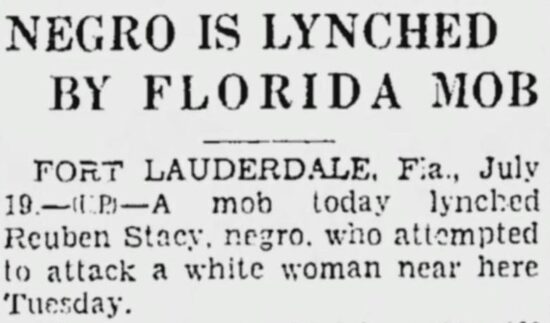During the turbulent and tragic history of racism and injustice in the United States, the lynching of Rubin Stacy stands out as a shameful chapter in our history. This horrid event unfolded in the summer of 1935 in Fort Lauderdale, Florida, amidst a backdrop of deep-seated hatred for African Americans.
Rubin Stacy, a black man of 29 on July 16, 1935, approached the home of Marion Jones asking for a drink of water. Jones, frightened, screamed in fear and reported Stacy to the local police. In fear for his life, Stacy ran. After a three-day search, Stacy was apprehended and jailed.
On July 19, 1935, a mob of white residents descended upon the jail where Rubin Stacy was being held. They dragged him from his cell, brutally beat him, and then lynched him from a tree not far from Marion Jones’s home. The entire incident was a grotesque spectacle. Onlookers consisting of men, women, and children gathered to witness the horrifying act.
A coroner’s report concluded that Stacy died at the hands of persons unknown. This ended the investigation asked for by the then-governor of the state. No one was ever charged and brought to justice.
But, fifty years later, witnesses came forward. They said the then Sheriff Clark and his deputy brother planned and instigated the lynching of Stacy. Unfortunately, during their indictment for corruption, witnesses suddenly did not remember their original testimony. They were cleared of their charges. This in and of itself confirmed the existence of the deep corruption, racism, and white supremacy within the state government.
This lynching was not an isolated incident. It was part of a broader pattern of racial violence and terror that African Americans endured for decades to come. Rubin Stacy’s death, like so many others, brought to light the injustice of systemic racism that plagued the criminal justice system in American society at the time. And still to this day.
Rubin Stacy’s story serves as a sad reminder of the injustices that have scarred America’s history. It underscores the need for ongoing efforts to confront and address racial inequality, bigotry, and hatred. As we look back on this scar across our nation’s history, we must strive for a more just and equitable future, one where all individuals are treated with dignity and respect, regardless of their race or background.
Source:
